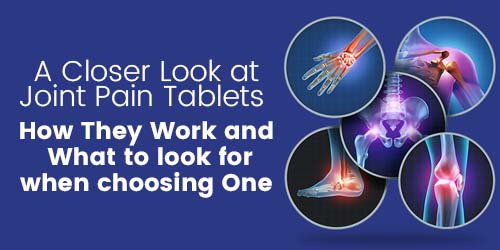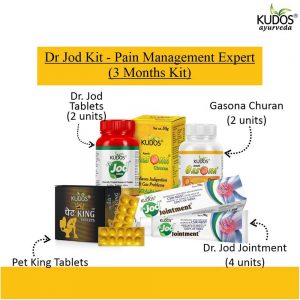A Closer Look at Joint Pain Tablets: How They Work and What to Look for When Choosing One
Joint health plays a vital role in our overall well-being, enabling us to move, exercise, and perform daily activities with ease. However, joint pain is a common issue that affects millions of people worldwide. Whether caused by aging, injury, arthritis, or other underlying conditions, joint pain can significantly impact one’s quality of life. Fortunately, joint pain tablets have emerged as a popular and effective treatment option, providing relief and improving joint function. In this article, we will explore the importance of joint health, the prevalence of joint pain, and delve into the benefits and considerations of joint pain tablets as a solution.
Joint Pain Tablets

Joint pain tablets have gained popularity as a reliable and accessible treatment option for individuals seeking relief from joint pain. These tablets typically contain ingredients that target inflammation, reduce pain, and promote joint health. Here are some key benefits and considerations associated with joint pain tablets:
- Pain Relief: Joint pain tablets are formulated to provide effective pain relief, addressing discomfort associated with joint inflammation, swelling, and stiffness. They often contain analgesic properties that help to alleviate pain and improve daily comfort.
- Anti-Inflammatory Effects: Inflammation is a common underlying cause of joint pain. Joint pain tablets often contain anti-inflammatory agents that reduce inflammation, thereby mitigating pain and promoting joint healing.
- Improved Joint Function: By targeting the root causes of joint pain, these tablets can improve joint function. They aid in reducing stiffness, increasing flexibility, and enhancing overall mobility, enabling individuals to engage in activities with greater ease and comfort.
- Convenience and Accessibility: Joint pain tablets are widely available over-the-counter and can be easily incorporated into one’s daily routine. They offer a convenient and accessible treatment option, allowing individuals to manage their joint pain effectively.
- Minimal Side Effects: Compared to stronger prescription medications, joint pain tablets generally have fewer side effects. However, it is essential to follow the recommended dosage and consult a healthcare professional if necessary.
- Complementary Therapy: Joint pain tablets can be used as part of a comprehensive approach to managing joint pain. They can be combined with lifestyle modifications, physical therapy, exercise, and other treatments to optimize results.
- Individual Considerations: It’s important to note that joint pain tablets may not be suitable for everyone. Factors such as underlying health conditions, allergies, and interactions with other medications should be taken into account.
How Joint Pain Tablets Work
Joint pain tablets are designed to address the underlying causes of joint pain and provide relief. They typically work through the following mechanisms:
- Anti-inflammatory properties: Many joint pain tablets contain ingredients with anti-inflammatory properties. These substances help reduce inflammation in the joints, which is often a leading cause of pain and swelling. By targeting inflammation, these tablets alleviate discomfort and promote healing.
- Analgesic (pain-relieving) effects: Joint pain tablets often have analgesic properties, which means they help relieve pain. They work by blocking pain signals and reducing the perception of pain, allowing individuals to experience relief and improved comfort.
- Promoting joint lubrication and repair: Some joint pain tablets contain ingredients that support joint health and function. These substances help promote the production of synovial fluid, which lubricates the joints, reduces friction, and improves mobility. Additionally, certain tablets may include components that aid in repairing damaged cartilage and tissues, supporting overall joint health.
Types of Joint Pain Tablets:
- Nonsteroidal Anti-Inflammatory Drugs (NSAIDs): NSAIDs are a commonly used class of joint pain tablets. They work by inhibiting the production of certain enzymes responsible for inflammation and pain. Ibuprofen, naproxen, and diclofenac are among NSAIDs. It’s important to note that long-term or excessive use of NSAIDs may have potential side effects, such as gastrointestinal issues or increased risk of cardiovascular problems. Individuals with specific health conditions or those taking other medications should consult a healthcare professional before using NSAIDs.
- Acetaminophen (Paracetamol): Acetaminophen, also known as paracetamol, is a pain-relieving ingredient commonly found in joint pain tablets. While it lacks significant anti-inflammatory properties, it can effectively relieve pain. Acetaminophen is suitable for individuals who cannot tolerate NSAIDs due to allergies or other health concerns. However, it’s important to follow the recommended dosage and avoid exceeding the maximum daily limit to prevent potential liver damage.
- Glucosamine and Chondroitin: Glucosamine and chondroitin are naturally occurring substances found in joint pain tablets. They play a crucial role in maintaining healthy joint cartilage and promoting joint lubrication. While scientific evidence on their effectiveness is mixed, some studies suggest that these supplements may provide benefits for certain individuals, particularly those with osteoarthritis. It’s recommended to consult with a healthcare professional to determine the appropriate dosage and suitability for individual needs.
- Topical Pain Relievers: In addition to oral tablets, there are topical pain relievers available in the form of creams, gels, and patches. These products are applied directly to the affected area, providing localized relief. Topical pain relievers often contain ingredients such as menthol or capsaicin, which create a cooling or warming sensation to distract from the pain. They can be a convenient option for individuals who prefer targeted relief or want to avoid potential systemic side effects associated with oral medications. It’s important to follow the instructions and consider any allergies or skin sensitivities before using topical pain relievers.
Complementary Strategies for Joint Pain Management
In addition to using joint pain tablets, there are various complementary strategies that can help individuals effectively manage joint pain. These approaches focus on promoting overall joint health, reducing inflammation, and improving mobility. Here are some key strategies to consider:
Lifestyle Modifications:
- Exercise: Regular exercise is crucial for maintaining joint health. Low-impact activities such as walking, swimming, or cycling can help strengthen the muscles around the joints, improve flexibility, and reduce pain. It’s important to consult with a healthcare professional or a physical therapist to develop an exercise routine that suits individual needs and limitations.
- Weight Management: Maintaining a healthy weight is beneficial for reducing stress on the joints, particularly weight-bearing joints like the knees and hips. Losing excess weight can help alleviate joint pain and improve mobility. A balanced diet and portion control, combined with regular physical activity, can contribute to weight management.
- Physical Therapy: Physical therapy can be a valuable component of joint pain management. A trained therapist can provide exercises and techniques tailored to specific joint conditions, helping to improve range of motion, strengthen muscles, and alleviate pain.
Alternative Therapies:
- Acupuncture: Acupuncture is an ancient Chinese practice that involves inserting thin needles into specific points of the body. It is believed to help balance the body’s energy flow and stimulate natural pain-relieving mechanisms. Some individuals find acupuncture helpful in reducing joint pain and improving overall well-being.
- Herbal Supplements: Certain herbal supplements, such as turmeric, ginger, and boswellia, have been traditionally used for their potential anti-inflammatory properties. However, it’s essential to consult with a healthcare professional before incorporating herbal supplements into a joint pain management plan, as they may interact with medications or have individual contraindications.
Potential Benefits of a Multidisciplinary Approach:
Combining different therapies and treatments is part of a multidisciplinary approach to joint pain management. This strategy might involve working together with medical experts from several specialties, like rheumatologists, orthopedic surgeons, physical therapists, and pain management experts. A multidisciplinary approach can offer a more comprehensive and individualized approach to managing joint pain by integrating multiple viewpoints and expertise. Depending on the person’s particular requirements and preferences, it could involve a mix of prescription medication, physical activity, physical therapy, and alternative therapies.
Conclusion
For overall wellbeing and quality of life, maintaining healthy joints and successfully treating joint pain are essential. We have discussed the significance of joint health and the role of joint pain medications as a common form of treatment in this post. Furthermore, we have emphasized the importance of taking a comprehensive approach to joint pain care and integrating complimentary techniques for the best outcomes. By reducing inflammation and enhancing overall wellbeing, complementary and alternative therapies like acupuncture and herbal supplements can also aid in the management of joint pain. Additionally, adopting a multidisciplinary strategy that entails working with healthcare experts from multiple disciplines can offer a specialized and comprehensive treatment plan catered to unique needs and objectives.
In conclusion, controlling joint pain entails more than just using joint pain medications. It necessitates a thorough and holistic strategy that include medication, dietary changes, complementary therapies, and a multidisciplinary strategy. People can improve joint health, lower inflammation, and increase mobility by using these measures, which will ultimately improve their quality of life. To create a comprehensive plan that covers specific needs and guarantees a holistic approach to joint pain management, it is advised to engage with healthcare professionals.




